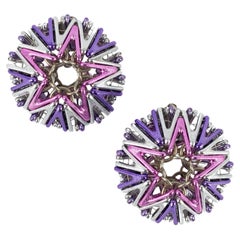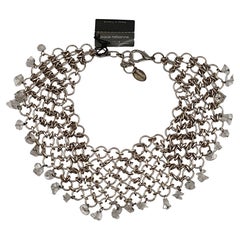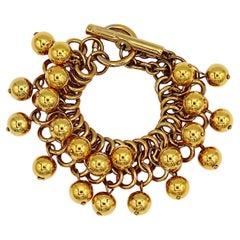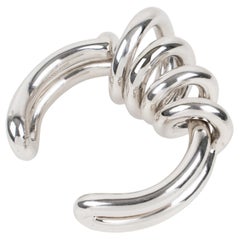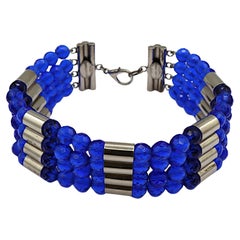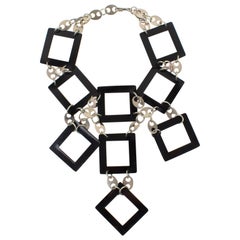Paco Rabanne Jewelry
Visionary designer Paco Rabanne first made a name for himself in the 1960s when he introduced dresses, handbags and other clothing and accessories that went against the common sensibilities of the time and challenged the public's perception of what fashion should be. By working with unlikely materials such as paper and Rhodoid — a cellulose acetate plastic often used to line baking pans — Rabanne forced the fashion world to reconsider materials and form.
Rabanne was born Francisco Rabaneda y Cuervo in Spain’s Basque region. His mother was the head seamstress at Balenciaga when she relocated herself and her son to France in 1939 to escape the Spanish Civil War. Once in France, he took on the name Paco Rabanne.
Rabanne studied architecture at the Ecole Nationale Supérieure des Beaux-Arts in Paris but pivoted toward fashion and began to design accessories and costume jewelry. Rabanne collaborated with many acclaimed luxury houses — his early clients included Charles Jourdan, Givenchy, Pierre Cardin and Dior.
By 1966, Rabanne was working on avant-garde designs in his own newly-opened studio. He introduced a couture collection titled “Twelve Unwearable Dresses in Contemporary Materials.” The garments — made of aluminum, plastic and eco-friendly paper and fastened with wire — were unveiled at a show that featured music and models of color (both uncommon characteristics for such an event). Sculptural, sexy and solidly Space Age in appearance, Rabanne’s experiments turned heads. Pop star-actresses Brigitte Bardot and Françoise Hardy would soon be seen in the designer’s iconic metallic dresses, and Rabanne found enthusiasts in the likes of revolutionary couturier Elsa Schiaparelli and art collector Peggy Guggenheim. In 1968 Rabanne designed leather boots and erotically charged dresses made of molded plastic and chain-mail mesh for the science fiction film Barbarella.
Rabanne called Salvador Dalí a close friend and drew on the Surrealist movement in his designs. He continued to use unconventional materials in his work. From aluminum jersey and fur to ostrich feathers and Velcro, everything was suitable for his pioneering garments. And Rabanne’s talents are diverse — his prolific output even includes stylish furniture.
In 1999 Rabanne retired from the fashion business. In 2010 he was named Officer of the Legion d’Honneur by the French culture minister. Today, under the creative direction of French designer Julien Dossena, the Paco Rabanne brand continues to innovate and offer looks that nod to the past as well as the future.
Find vintage Paco Rabanne clothing and accessories on 1stDibs.
1990s French Paco Rabanne Jewelry
21st Century and Contemporary French Paco Rabanne Jewelry
21st Century and Contemporary French Paco Rabanne Jewelry
2010s French Modern Paco Rabanne Jewelry
20th Century French Paco Rabanne Jewelry
1960s French Modernist Vintage Paco Rabanne Jewelry
Enamel
1980s American Modernist Vintage Paco Rabanne Jewelry
Base Metal
Early 2000s French Paco Rabanne Jewelry
1990s French Paco Rabanne Jewelry
2010s Paco Rabanne Jewelry
1980s French Modernist Vintage Paco Rabanne Jewelry
21st Century and Contemporary French Paco Rabanne Jewelry
21st Century and Contemporary French Paco Rabanne Jewelry
15th Century and Earlier French Antique Paco Rabanne Jewelry
20th Century French Paco Rabanne Jewelry
1990s French Paco Rabanne Jewelry
1990s French Paco Rabanne Jewelry
1990s French Modernist Paco Rabanne Jewelry
Silver Plate
1990s French Modernist Paco Rabanne Jewelry
Quartz
1970s Vintage Paco Rabanne Jewelry
20th Century French Paco Rabanne Jewelry
2010s Paco Rabanne Jewelry
1960s French Modernist Vintage Paco Rabanne Jewelry
Gold Plate, Brass
1960s French Vintage Paco Rabanne Jewelry
1980s French Modernist Vintage Paco Rabanne Jewelry
1990s Paco Rabanne Jewelry
21st Century and Contemporary French Paco Rabanne Jewelry
1970s French Vintage Paco Rabanne Jewelry
Gilt Metal
Early 2000s Paco Rabanne Jewelry
Early 2000s Paco Rabanne Jewelry
Early 2000s French Paco Rabanne Jewelry
Silver Plate
21st Century and Contemporary French Paco Rabanne Jewelry
Excellent condition.
1980s French Vintage Paco Rabanne Jewelry
1980s French Vintage Paco Rabanne Jewelry
Gilt Metal
20th Century French Paco Rabanne Jewelry
Early 2000s Paco Rabanne Jewelry
Early 2000s French Paco Rabanne Jewelry
Base Metal
1990s French Artist Paco Rabanne Jewelry
Gilt Metal
1990s French Paco Rabanne Jewelry
20th Century French Paco Rabanne Jewelry
Early 2000s French Paco Rabanne Jewelry
Silver Plate
Paco Rabanne jewelry & watches for sale on 1stDibs.
Creators Similar to Paco Rabanne
- What happened to Paco Rabanne?1 Answer1stDibs ExpertMarch 25, 2024The story of what happened to Paco Rabanne centers on a name change. The French fashion house's founder, Paco Rabanne, passed away in 2023. A few months later, the label announced its intentions to drop Paco from its name and begin operating under Rabanne. The brand had previously gone on hiatus in 1999 following Paco Rabanne's retirement, only to be revived under the leadership of a new creative director, Manish Arora, in 2011. Julien Dossena took over the role in 2013 and continued to guide the fashion house through its name change and rebranding. Shop a collection of Paco Rabanne apparel and accessories on 1stDibs.
- 1stDibs ExpertFebruary 21, 2024The fashion house Paco Rabanne is no longer called by its former name due to a shift in its approach to design. In 2023, the luxury fashion brand announced its intentions to drop Paco from the name and rebrand as Rabanne. The move coincided with the fashion house's 60th anniversary and reflected a move toward simpler, more minimal pieces. On 1stDibs, shop a range of Paco Rabanne apparel and accessories.
